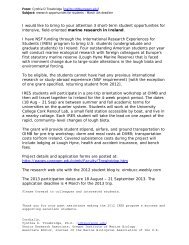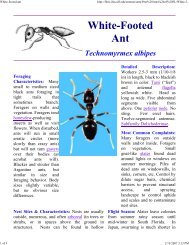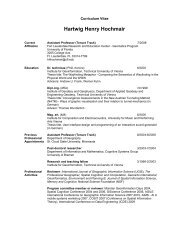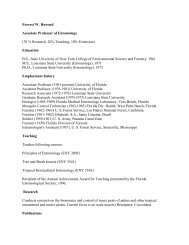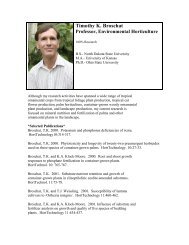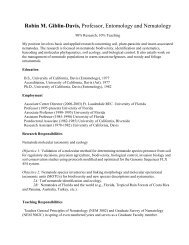West Indian Sugarcane Borer, Metamasius hemipterus sericeus ...
West Indian Sugarcane Borer, Metamasius hemipterus sericeus ...
West Indian Sugarcane Borer, Metamasius hemipterus sericeus ...
You also want an ePaper? Increase the reach of your titles
YUMPU automatically turns print PDFs into web optimized ePapers that Google loves.
TropicLine6(4) http://flrec.ifas.ufl.edu/tropicline/Volume6(4).htm<br />
with and without fermenting plant tissue to M. h. <strong>sericeus</strong> adults in the<br />
field.<br />
Lethal traps baited with 250 g of chopped sugarcane were used to survey<br />
plantings of sugarcane, banana, or ornamental palms in Broward (3 sites),<br />
Dade (10 sites), and Palm Beach (8 sites) Counties during March-September<br />
1993. Each survey location received 2-7 traps. We worked with Broward,<br />
Dade, and Palm Beach county extension units, personnel with the Florida<br />
Department of Agriculture and Consumer Services, Division of Plant<br />
Industry, and cooperative growers to locate active M. h. <strong>sericeus</strong><br />
infestations and candidate sites for survey and observation of symptoms in<br />
host plants.<br />
<strong>Metamasius</strong> <strong>hemipterus</strong> <strong>sericeus</strong> were trapped near and in banana plantings,<br />
sugarcane fields, and fields of ornamental palms in southern Dade County<br />
and Pahokee and Belle Glade, Palm Beach County. In central and western<br />
Broward County, M. h. <strong>sericeus</strong> were trapped near and in small banana<br />
plantings and fields of ornamental palms.<br />
We observed larval infestations of M. h. <strong>sericeus</strong> in the following palms<br />
during 1991-1993 in Florida: 1) forty healthy (Dade Co.) and about 20<br />
wounded (Dade and Broward Co.) 3-4-year-old, field grown spindle palms,<br />
Hyophorbe verschaffeltii; 2) two 3-4-year-old healthy Canary Island date<br />
palms, Phoenix canariensis in Dade Co.; 3) three healthy MacArthur palms,<br />
Ptychosperma macarthurii in Dade Co.; 4) more than one hundred 3-4-year-old<br />
healthy field grown Majesty palms, Ravenea rivularis in Palm Beach Co.; 5)<br />
six 3-4-year-old healthy field grown royal palms, Roystonea regia in<br />
Broward and Palm Beach Co.; and 6) two 3-4-year-old healthy Washington fan<br />
palms, Washingtonia robusta in Dade Co.<br />
<strong>Metamasius</strong> <strong>hemipterus</strong> <strong>sericeus</strong> larval tunneling appeared to start in<br />
petioles or wounds in the petioles, crown, or stem and was extended into<br />
healthy stem tissue. Symptoms that we observed included: 1) the appearance<br />
of a dark amber-colored gummy exudate which issued from openings to the<br />
surface from larval galleries in the stem and petioles of the crown region<br />
or sometimes in the stem near or amongst exposed roots (R. regia); and 2)<br />
open 1.0-1.5 cm diam. larval galleries in the leaves, petioles, and stem.<br />
Signs included abandoned cocoons made of stem or petiole fibers, and/or<br />
adult, larval, and pupal weevils at the base of petioles and in galleries<br />
in the stem. The overall symptoms were of a lethal wilt with general<br />
chlorosis and premature leaf death in all of the P. macarthurii, and in<br />
several H. verschaffeltii and R. rivularis examined. Eventually, the crown<br />
in these palms was completely destroyed by larval tunneling and collapsed.<br />
Because the smooth, columnar trunks of H. verschaffeltii, R. rivularis, and<br />
R. regia are an important part of their aesthetic appeal, even light damage<br />
by M. h. <strong>sericeus</strong> is of economic importance. The W. robusta that we<br />
examined were booted (with old petioles attached) and assymptomatic for M.<br />
h. <strong>sericeus</strong> damage until the boots were removed near the crown revealing<br />
typical larval weevil damage. Booted species of palms would have a higher<br />
threshold for aesthetic damage to trunks but could suffer because high<br />
densities of undetectable M. h. <strong>sericeus</strong> might build-up and stress or kill<br />
the tree or provide access for pathogenic organisms. Palms that are<br />
assymptomatic for early M. h. <strong>sericeus</strong> damage could escape early detection<br />
and provide refuge during insecticide treatments in palm field nurseries. A<br />
chemically-mediated lethal trap for M. h. <strong>sericeus</strong> would be extremely<br />
useful for monitoring, mass-trapping, or pathogen delivery in such cases.<br />
2 of 3 2/7/2007 2:17 PM



